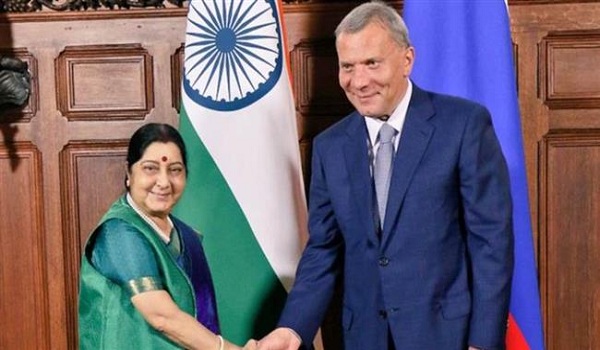Senior Indian and Russian officials have discussed ways to develop trade ties and remove barriers in investment, science and technology as well as other issues of mutual interests, according to Press T.V.
India’s External Affairs Minister Sushma Swaraj and Russian Deputy Prime Minister Yuri Borisov held talks over bilateral matters during the 23rd Inter Governmental Commission (IGC) in Moscow on Friday.
“India and Russia enjoy a special and privileged strategic partnership,” Swaraj said in a statement after the meeting. “This partnership has strengthened over time and covers a vast agenda involving almost all sphere of human activity. India attaches the highest importance to its relations with Russia.”
The commission has met in the run up to the 19th India-Russia Annual Summit which is expected to be held in India early next month. Russian President Vladimir Putin is to visit India for the summit and meet with Prime Minister Narendra Modi.
“The Deputy Prime Minister and I have conducted a comprehensive review of our relations. I am satisfied with the outcomes of our meeting,” Swaraj said.
“I am confident that our deliberations today will further strengthen our cooperation with Russia in all fields in existing and new areas of cooperation,” the minister added.
During the meeting, the two sides discussed ways to enhance bilateral trade which in 2017 reached $10.17 billion.
“We discussed ways and means to increase this momentum, ensure balanced trade, and remove barriers to trade,” Swaraj said. “Two-way investments have already crossed the $30 billion target, which we had set for 2025. We have therefore proposed that we enhance this figure to $50 billion by 2025.”
Swaraj went on to say that the two sides had identified new areas of cooperation in agriculture, infrastructure, transport, space and Science and Technology, and discussed the possibilities of working together on projects in third countries as a new dimension of strategic partnership.
The Russian deputy prime minister, for his part, said that Moscow and New Delhi were on track to bring the trade turnover to $30 billion in the coming years.
“Over the past years bilateral trade has reached solid growth rates, which if maintained will help us hit the target of $30 billion in the coming years,” Borisov was quoted as saying by Russia’s state-run Tass news agency.
 Swaraj, who is visiting Russia for the third time in 11 months, also met Russian Foreign Minister Sergei Lavrov on Thursday.
Swaraj, who is visiting Russia for the third time in 11 months, also met Russian Foreign Minister Sergei Lavrov on Thursday.
The Friday meeting came as India was pushing Washington to execute the certification of Russia’s S-400 missile system deal before Putin’s visit to India in early-October so that New Delhi can go ahead with the signing of the deal without attracting economic sanctions from the US under CAATSA.
India has long wanted the US to extend a waiver for the purchase of S-400 system from Russia.
The US Congress passed the Countering America’s Adversaries through Sanctions Act (CAATSA) against Russia in August 2017 over allegations of interfering in the 2016 presidential election. The law, among other things, imposes sanctions on countries and companies who engage in contracts to purchase weaponry from Russia.
“While the Countering America’s Adversaries through Sanctions Act (CAATSA) was passed unanimously by the US Congress, and signed reluctantly by US President Donald Trump, the US Congress has now passed a law granting waiver to some countries,” a source told The Indian Express India on Friday.
“India is one of the intended beneficiaries, but the US President has to personally certify the deal. We want this fairly routine administrative process to be completed before the Russian President’s visit, so that we can sign the deal,” the source added.
Reports said negotiations over the deal were at an “advanced stage,” and the agreement is expected to be signed before the Putin-Modi summit.
India and Russia concluded price negotiations for procurement of five regiments of Russian-made S-400 advanced air defense systems in May.
The S-400 Triumf (with the NATO codename Growler) entered service in 2007 and is considered Russia’s most advanced long-range anti-aircraft missile system.
Capable of engaging targets at a distance of 400 kilometers and at an altitude of up to 30 kilometers, the missile system can destroy aircraft, cruise and ballistic missiles. It can also be used against land-based targets.
R.S

